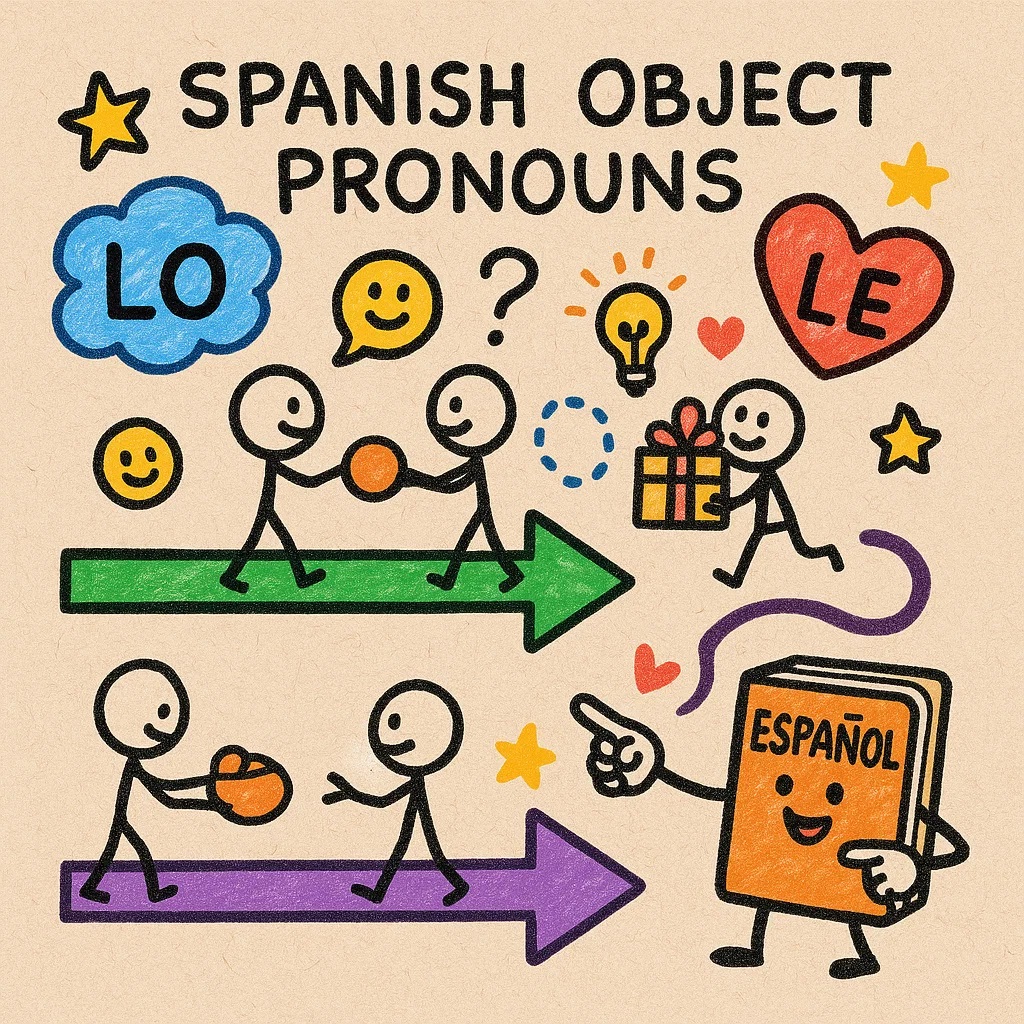Article created on May 21, 2025, article updated on May 22, 2025, by Sandra Sánchez

Content:
- Introduction: Unlocking the Mystery of Spanish Object Pronouns
- Section 1: Understanding Direct vs. Indirect Objects
- Section 2: Spanish Direct Object Pronouns
- Section 3: Spanish Indirect Object Pronouns
- Section 4: Where to Place Object Pronouns in Spanish
- Section 5: Using Direct and Indirect Object Pronouns Together
- Section 6: Regional Variations and Leísmo
- Section 7: Overcoming Common Challenges
- Section 8: Practical Application Strategies
- Frequently Asked Questions
- Your Spanish Pronoun Roadmap: From Confusion to Confidence
Introduction: Unlocking the Mystery of Spanish Object Pronouns
Ever found yourself lost in the maze of Spanish pronouns, wondering whether to use “lo,” “la,” “le,” or some combination thereof? You’re not alone. For English speakers, Spanish object pronouns often seem like a grammatical puzzle with pieces that don’t quite fit together. But here’s the straight talk: mastering these pronouns isn’t about memorizing endless rules—it’s about understanding the logic behind them.
Object pronouns in Spanish function as essential building blocks for natural, fluid communication. Whether you’re a beginner struggling with basic sentence construction or an intermediate learner aiming to sound more like a native speaker, this guide will transform what feels like a grammatical headache into a powerful tool for expression.
Section 1: Understanding Direct vs. Indirect Objects
Before diving into pronouns specifically, we need to clarify what direct and indirect objects actually are. This distinction forms the foundation of everything that follows.
What is a Direct Object?
A direct object answers the question “what?” or “whom?” and directly receives the action of the verb. It’s the noun that’s most affected by the verb’s action.
Example: Juan reads the book. (¿What does Juan read? The book.)
What is an Indirect Object?
An indirect object answers the question “to whom?” or “for whom?” the action is performed. It’s typically the recipient of the direct object.
Example: Juan gives María the book. (Juan gives the book to whom? To María.)
Think of it this way: if the verb is like throwing a ball, the direct object is the ball itself, while the indirect object is the person you’re throwing it to.

Section 2: Spanish Direct Object Pronouns
Direct object pronouns replace direct objects to avoid repetition. They answer the question: What or whom is receiving the action?
| Person | English Pronoun | Spanish Direct Object Pronoun | Example |
|---|---|---|---|
| 1st person singular | me | me | Ella me ve. (She sees me.) |
| 2nd person singular | you | te | Él te llama. (He calls you.) |
| 3rd person singular (masc.) | him/it | lo | Yo lo compro. (I buy it.) |
| 3rd person singular (fem.) | her/it | la | Tú la ves. (You see her.) |
| 1st person plural | us | nos | Ellos nos invitan. (They invite us.) |
| 2nd person plural | you all | os | Yo os escucho. (I listen to you all.) |
| 3rd person plural (masc.) | them | los | Nosotros los vemos. (We see them.) |
| 3rd person plural (fem.) | them | las | Él las compra. (He buys them.) |
Common Usage Patterns
Let’s see how direct object pronouns work in practice:
- Original: Compro el libro. (I buy the book.)
With pronoun: Lo compro. (I buy it.) - Original: Veo a María. (I see María.)
With pronoun: La veo. (I see her.) - Original: Leemos los artículos. (We read the articles.)
With pronoun: Los leemos. (We read them.)
Pro Tip: In Spanish, direct object pronouns for people often retain gender distinctions that English doesn’t have. For example, “I see him” is “Lo veo,” while “I see her” is “La veo.”
Section 3: Spanish Indirect Object Pronouns

Indirect object pronouns replace the recipient of an action (to whom/for whom something is done). They often correspond to “to me,” “to you,” “to him/her,” etc., in English.
| Person | English Pronoun | Spanish Indirect Object Pronoun | Example |
|---|---|---|---|
| 1st person singular | to/for me | me | Ella me da el libro. (She gives the book to me.) |
| 2nd person singular | to/for you | te | Él te escribe una carta. (He writes a letter to you.) |
| 3rd person singular | to/for him/her/it | le | Yo le envío un email. (I send an email to him/her.) |
| 1st person plural | to/for us | nos | Ellos nos traen regalos. (They bring gifts to us.) |
| 2nd person plural | to/for you all | os | Yo os cuento un secreto. (I tell a secret to you all.) |
| 3rd person plural | to/for them | les | Nosotros les compramos comida. (We buy food for them.) |
Key Differences from Direct Object Pronouns
Notice that indirect object pronouns don’t distinguish gender—le can mean “to him,” “to her,” or even “to it,” depending on context. This differs from direct object pronouns where gender matters (lo vs. la).
Common Usage Patterns
- Original: Doy el regalo a mi madre. (I give the gift to my mother.)
With pronoun: Le doy el regalo. (I give her the gift.) - Original: Escribo cartas a mis amigos. (I write letters to my friends.)
With pronoun: Les escribo cartas. (I write them letters.) - Original: Compras flores para nosotros. (You buy flowers for us.)
With pronoun: Nos compras flores. (You buy us flowers.)
Common Challenge: Many learners struggle with the lack of gender distinction in indirect object pronouns. Remember that context usually clarifies who the recipient is. If needed, you can add clarification: “Le di el libro a María” (I gave the book to María).
Section 4: Where to Place Object Pronouns in Spanish
The placement of object pronouns follows specific patterns in Spanish. Mastering these positions is crucial for constructing grammatically correct sentences.
Basic Placement Rules
- Before conjugated verbs:
- La veo. (I see her.)
- Te llamamos ayer. (We called you yesterday.)
- Attached to infinitives:
- Quiero verla. (I want to see her.)
- Necesito llamarte. (I need to call you.)
- Attached to gerunds:
- Estoy viéndola. (I am seeing her.)
- Sigo buscándote. (I keep looking for you.)
- Attached to affirmative commands:
- Dámelo. (Give it to me.)
- Escríbele. (Write to him/her.)
- Before negative commands:
- No me lo des. (Don’t give it to me.)
- No le escribas. (Don’t write to him/her.)
Frequency of Pronoun Placement Contexts
80%
60%
30%
45%
25%
Based on frequency analysis of conversational Spanish
When you have flexibility (such as with infinitives), placement can sometimes be a matter of regional preference or style. However, with conjugated verbs, the rules are strict.

Section 5: Using Direct and Indirect Object Pronouns Together
Here’s where things get interesting—and sometimes challenging. When both direct and indirect object pronouns appear in the same sentence, they follow a specific order and sometimes undergo changes.
The Order Rule: Indirect First, Then Direct
The formula is simple: Indirect Object Pronoun + Direct Object Pronoun + Verb
- Original: Juan da el libro a María. (Juan gives the book to María.)
- With pronouns: Juan le lo da. ⚠️ Incorrect!
- Correct form: Juan se lo da. (Juan gives it to her.)
Important: When le or les (indirect object pronouns) is followed by lo, la, los, or las (direct object pronouns), le/les changes to se. This is purely for pronunciation reasons.
Real-Life Example: A Text Message Conversation
María: ¿Has visto mi libro nuevo? (Have you seen my new book?)
Juan: Sí, lo vi en la mesa. (Yes, I saw it on the table.)
María: ¿Puedes traérmelo, por favor? (Can you bring it to me, please?)
Juan: Claro, te lo traigo ahora mismo. (Sure, I’ll bring it to you right now.)
María: Gracias. Mi hermano también quiere verlo. ¿Se lo puedes mostrar después? (Thanks. My brother also wants to see it. Can you show it to him later?)
Juan: Sí, se lo mostraré cuando venga. (Yes, I’ll show it to him when he comes.)
Notice how in this conversation, we see:
- Direct object pronoun alone: “lo vi” (I saw it)
- Infinitive with attached pronouns: “traérmelo” (to bring it to me)
- Two pronouns before verb: “te lo traigo” (I’ll bring it to you)
- The le → se transformation: “se lo mostraré” (I’ll show it to him)
Section 6: Regional Variations and Leísmo
Spanish, like any global language, has regional variations in pronoun usage. The most notable is a phenomenon called leísmo.
What is Leísmo?
Leísmo is the use of le (normally an indirect object pronoun) in place of lo as a direct object pronoun, typically when referring to male persons.
Standard: Lo vi ayer. (I saw him yesterday.)
Leísmo: Le vi ayer. (I saw him yesterday.)
This practice is common in parts of Spain, particularly in central and northern regions, and is even considered standard in those areas when referring to male persons. However, in most of Latin America and according to the Royal Spanish Academy, the standard distinction between lo (direct) and le (indirect) is maintained.
“Understanding regional variations like leísmo helps learners not only to speak correctly but also to better comprehend Spanish as it’s actually spoken across different countries.”
— Dr. María López, Professor of Hispanic Linguistics, Universidad de Salamanca
For most learners, especially those focusing on Latin American Spanish, sticking to the standard rules is recommended until you become more advanced and can recognize regional preferences.

Section 7: Overcoming Common Challenges
Challenge 1: Identifying Direct vs. Indirect Objects
Many English speakers struggle to differentiate between direct and indirect objects, especially since English doesn’t always make this distinction clear through pronouns.
Solution: Train yourself to ask these questions:
- “What/whom is receiving the action directly?” → Direct object
- “To/for whom is the action being done?” → Indirect object
Practice with simple sentences until this becomes intuitive.
Challenge 2: Remembering Pronoun Placement
The varying placement rules for pronouns can be confusing, especially when dealing with compound verbs or commands.
Solution: Break it down by verb form:
- Conjugated verbs: pronouns go before
- Infinitives and gerunds: pronouns can attach at the end
- Affirmative commands: pronouns attach at the end
- Negative commands: pronouns go before the verb
Create flashcards with example sentences for each case.
Challenge 3: The “le/les → se” Transformation
Many learners forget to change le/les to se when followed by a direct object pronoun.
Solution: Create a mental trigger. Whenever you see or plan to use le/les followed by lo/la/los/las, automatically convert it to se. Practice with sentences like:
- Quiero darle el libro → Quiero dárselo
- Les compramos las entradas → Se las compramos
Section 8: Practical Application Strategies
Moving from theory to practice is essential for internalizing object pronouns. Here are effective strategies to incorporate them into your language learning routine:
1. Sentence Transformation Exercises
Take simple sentences and practice replacing nouns with appropriate pronouns:
- Compro el pan. → Lo compro.
- Doy flores a mi madre. → Le doy flores. → Se las doy.
2. Contextual Listening
Listen to Spanish conversations (podcasts, TV shows, etc.) with a specific focus on identifying object pronouns. Note how native speakers use them naturally.
3. Pattern Recognition
Identify common verb patterns that typically take direct or indirect objects:
- Verbs that typically take direct objects: ver (to see), tener (to have), comprar (to buy)
- Verbs that typically take indirect objects: dar (to give), decir (to tell), explicar (to explain)
- Verbs that commonly take both: enviar (to send), mostrar (to show), traer (to bring)
4. Immersive Practice
Create situations where you must use object pronouns regularly:
- Join language exchange programs where you describe actions involving objects and people
- Keep a Spanish journal where you deliberately practice using pronouns
- Use flashcard apps with spaced repetition for pronoun practice
Case Study: Mark’s Pronoun Breakthrough
Mark, an intermediate Spanish learner, struggled with object pronouns for months. His breakthrough came when he implemented a daily routine:
- Morning: 10 minutes transforming sentences with object pronouns
- Commute: Listening to Spanish podcasts, mentally noting pronoun usage
- Evening: Speaking practice with a language partner, focusing on natural pronoun use
Within six weeks, Mark reported that pronouns had become “second nature” rather than a grammatical hurdle. His key insight: “I stopped translating from English and started thinking directly in terms of the action and who was affected by it.”
Frequently Asked Questions
How can I tell when to use “lo” versus “le” in Spanish?
Use “lo” (or “la” for feminine) when replacing a direct object—the person or thing directly receiving the action of the verb. Use “le” when replacing an indirect object—the person for whom or to whom something is done. For example, in “I give the book to him,” “the book” is the direct object (lo), and “to him” is the indirect object (le). Remember that in some regions of Spain, “le” is used for male persons even as direct objects (leísmo), but this isn’t standard throughout the Spanish-speaking world.
Why do “le” and “les” change to “se” in some sentences?
This transformation occurs specifically when an indirect object pronoun (le/les) appears alongside a direct object pronoun (lo, la, los, las) in the same sentence. For example, “Le doy el libro” (I give him the book) becomes “Se lo doy” (I give it to him) rather than “Le lo doy” (which would be difficult to pronounce). This is purely a phonetic change to make pronunciation smoother, not a change in meaning. The “se” in this context still functions as an indirect object pronoun.
How do I handle object pronouns with compound verb forms like “quiero ver” or “estoy haciendo”?
With compound verb structures, you have two placement options: either before the conjugated verb or attached to the end of the infinitive/gerund. For example, with “quiero verlo” (I want to see it), you can say either “Lo quiero ver” or “Quiero verlo.” Both are correct, though the attached form is often more common. With gerunds, you can say “Lo estoy haciendo” or “Estoy haciéndolo” (I am doing it). Remember that when attaching pronouns to infinitives or gerunds, you may need to add an accent mark to maintain the original stress pattern of the word.

Your Action Plan for Pronoun Mastery
- Identify: Train yourself to recognize direct and indirect objects in every sentence you encounter
- Transform: Practice replacing nouns with appropriate pronouns in increasingly complex sentences
- Combine: Master the art of using direct and indirect object pronouns together
- Listen: Attune your ear to how native speakers use these pronouns naturally
- Produce: Gradually incorporate pronouns into your own speaking and writing until they become automatic
Remember that even native Spanish speakers acquired these patterns through years of natural exposure and practice. Be patient with yourself as you integrate these concepts, and celebrate your progress along the way.
As you continue your Spanish journey, how might mastering these subtle grammatical elements change not just how you speak, but how you perceive the relationships between actions and their recipients in everyday communication?
“In language learning, it’s often the smallest words that carry the greatest impact. Master the pronouns, and you’ve mastered the heart of Spanish sentence construction.”
Need a Personal Spanish Teacher?
📌 Ready to get started? Leave your request today, and let’s make Spanish learning fun and effective for you!

